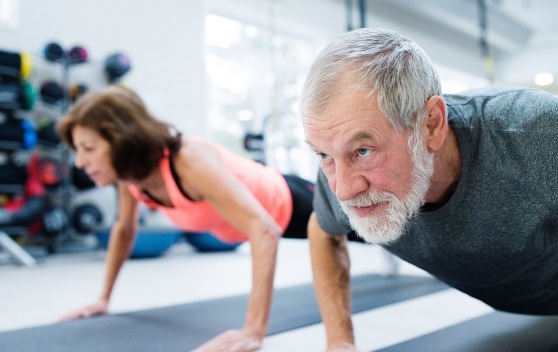The older I get, the more I am interested in the effects of ageing on our overall health span. Ageing is unavoidable, it happens to the best of us. Listed below are some of the physiological and biological changes that can occur the older we become:
- Insulin resistance – this is in healthy weight older adults also, with research showing there is more peripheral insulin resistance compared to a younger population (an inability to dispose of glucose into the tissue).
- Decreased availability of anabolic hormones, and increased frailty with lower levels of hormones
- Increased anabolic resistance, so not only is there a decrease in the hormones that signal tissue growth, the muscle tissue is less responsive to the stimulus of amino acids (protein) and exercise, and there is less muscle protein synthesis in comparison to breakdown.
- Greater protein requirements for the same relative gains in muscle, strength and function compared to a younger population
- Decreased motor neuron function, therefore less neural signalling to muscle tissues and reduced motor function.
- Increased intracellular oxidative stress, causing inflammation and reduced cell functioning
- Reduction in satellite (stem) cells numbers and regenerative capacity – these cells are essential for the maintenance and repair tissues in normal physiological processes or in response to muscle damage/trauma.
- Elevated myostatin signalling, a protein that blocks our ability to build muscle
- Increased chronic inflammation (also known as inflamm-aging)
- Changes in autophagy, where ageing reduces our ability to clear out damaged DNA
- Mitochondrial functioning abnormalities, where we can’t utilise energy metabolites as effectively to fuel mitochondria
- Reduced ability to be physically active (due to many of the reasons listed above)
Clearly, these are not all inevitable. However, it is a long, daunting, and rather depressing list of what can occur as we age – and we are an ageing population. There is no doubt that if we don’t look after this body we have got, then we really are staring down the barrel of a loaded gun.
The list above describes many of the mechanisms to explain the loss of muscle mass and function. It’s not about being ripped or having gainz, it’s about having proper functioning of the muscle so it can work effectively in our older years – this is what is shown to have the most positive impact on our cardiovascular, neurological and musculoskeletal systems.
Inactivity is the broader environmental issue that contributes substantially to the physiological issues I have mentioned above. We need to be active – in everyday life, and with some structured activity too. Hanging out washing and housework isn’t going to cut it, I’m afraid. I see a lot of people who have this idea that you don’t need to exercise in order to lose weight, and you can do it solely on diet alone. This is true, of course, but when you embark on any weight loss plan that restricts calories (i.e. any weight loss plan that is out there), then you will lose both fat weight and muscle mass – lowering your overall metabolic rate along with it. This is one of the reasons why weight regain is so prevalent. However the powerful combination of diet plus exercise helps sustainable weight loss. And exercise isn’t just moving around the house, doing chores – this should just be part of everyday living. Data looking at the effects of exercise show that resistance training confers benefits over and above what we would see if we were just doing 30 minutes of cardio-based exercise per day, something that many of us maintain, but it doesn’t offer the same benefits.
The right type and duration of exercise:
- increases insulin sensitivity
- increases body’s sensitivity to proteins (anabolic sensitivity)
- has anti-inflammatory properties
- improves mitochondrial functioning
The challenge is to get people exercising. And this is especially so for those who read what I have said above, and think that – on top of 30 minutes of aerobic training they don’t have time to do, they need to then put some resistance (or weight) training in.
This is not a call to encourage you to find an additional 3 hours in your week, though. In fact, a study that is about to be published (I heard about it on STEM talk) suggests that just 72 minutes a week in total is enough to help many of the conditions associated with ageing and poor health that I’ve mentioned above. Egan and colleagues found a combination of both resistance and cardiovascular exercise in a circuit-type setting for adults over 65 years just three times a week for 24 minutes increased walking speed, leg strength and reduced trunk fat. These measures speak to better muscular function, obviously increased strength, and will help reduce metabolic health risk. The improvements were more potent in this combined group than either resistance training or aerobic training for the same duration. It wasn’t olymic lifting from the sounds of it, but it also wasn’t lifting pink dumbbells, either.
So this was a very long preamble to the main message: if you are currently NOT exercising, then please start. While there are modalities that are better than others, seriously, anything will be better than nothing. The study I talked about is in older adults, you likely don’t need me to tell you that any age you start is obviously better than not starting at all. AND the earlier you start, the better the overall health outcomes.
There is often an argument as to which is best; exercise or diet for improving health. That’s a weird argument to my mind. Both are important and should be prioritised if you want more life in the years you’ve got left.

One of the only pics I could find that didn’t involve pink dumbbells. (PC: https://www.frieslandcampinainstitute.com/)